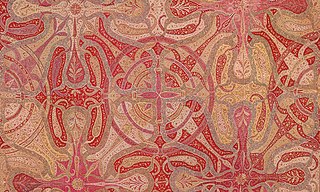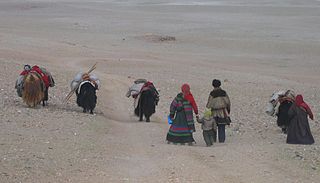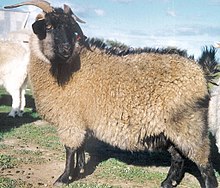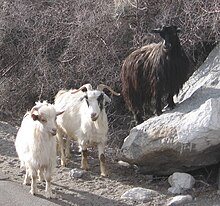
Wool is the textile fibre obtained from sheep and other mammals, especially goats, rabbits, and camelids. The term may also refer to inorganic materials, such as mineral wool and glass wool, that have properties similar to animal wool.

A herder is a pastoral worker responsible for the care and management of a herd or flock of domestic animals, usually on open pasture. It is particularly associated with nomadic or transhumant management of stock, or with common land grazing. The work is often done either on foot or mounted.

Cashmere wool, usually simply known as cashmere, is a fiber obtained from cashmere goats, pashmina goats, and some other breeds of goat. It has been used to make yarn, textiles and clothing for hundreds of years. Cashmere is closely associated with the Kashmir shawl, the word "cashmere" deriving from an anglicization of Kashmir, when the Kashmir shawl reached Europe in the 19th century. Both the soft undercoat and the guard hairs may be used; the softer hair is reserved for textiles, while the coarse guard hair is used for brushes and other non-apparel purposes.

Pashmina refers to, depending on the source, the cashmere wool of the Changthangi cashmere goat, for fine Kashmiri cashmere wool or a synonym for cashmere wool.

A shawl is a simple item of clothing, loosely worn over the shoulders, upper body and arms, and sometimes also over the head. It is usually a rectangular piece of cloth, but can also be square or triangular in shape. Other shapes include oblong shawls. It is associated with the inhabitants of the northern Indian subcontinent—particularly Kashmir and Punjab—and Central Asia, but can be found in many other parts of the world.

Shahtoosh, also known as Shatoush, is a wool obtained from the fur of the chiru. Also, shawls made from the wool of the chiru are called shahtoosh. Shahtoosh is the finest animal wool, followed by vicuña wool.

The Pygora goat is a breed of goat that originated from crossing the registered NPGA Pygmy goat and the white AAGBA Angora goat. Pygoras, along with the Angora goat and Cashmere goat, are fiber goats. Pygora goats produce three distinct kinds of fleece.

The Changtang is a part of the high altitude Tibetan Plateau in western and northern Tibet extending into the southern edges of Xinjiang as well as southeastern Ladakh, India, with vast highlands and giant lakes. From eastern Ladakh, the Changtang stretches approximately 1,600 kilometres (990 mi) east into Tibet as far as modern Qinghai. The Changtang is home to the Changpa, a nomadic Tibetan people. The two largest settlements within the Tibetan Changtang are Rutog Town the seat of Rutog County and Domar Township the seat of Shuanghu County.

The Australian Cashmere goat is a breed of Cashmere domestic goats originating in Australia. Whilst retaining the fertility and hardiness of the bush goat, the Australian Cashmere is quite different in appearance and temperament. In midwinter, it has an excellent overall coverage of long, dense cashmere.

Animal fibers are natural fibers that consist largely of certain proteins. Examples include silk, hair/fur and feathers. The animal fibers used most commonly both in the manufacturing world as well as by the hand spinners are wool from domestic sheep and silk. Also very popular are alpaca fiber and mohair from Angora goats. Unusual fibers such as Angora wool from rabbits and Chiengora from dogs also exist, but are rarely used for mass production.

The goat or domestic goat is a domesticated species of goat-antelope typically kept as livestock. It was domesticated from the wild goat of Southwest Asia and Eastern Europe. The goat is a member of the animal family Bovidae and the tribe Caprini, meaning it is closely related to the sheep. There are over 300 distinct breeds of goat. It is one of the oldest domesticated species of animal, according to archaeological evidence that its earliest domestication occurred in Iran at 10,000 calibrated calendar years ago.
The Chengde Down is a Chinese breed of cashmere goat. It originates in Hebei Province in northern China, on the border with Liaoning and Inner Mongolia. If hornless it may also be known as the Yanshan Polled.
The Hexi Cashmere goat breed from desert and semidesert regions of the North Gansu province of China is used primarily for the production of cashmere fiber. About 60% of the goats are white. The Hexi cashmere can be found in the Gansu, Qinghai and Ningxia provinces. A typical adult doe produces 184 grams of down at 15.7 micrometres (µm) diameter.
The Zhongwei (Chung-wei) is a breed of goat from the Ningxia Hui Autonomous Region and Gansu Province of China. It lives on arid desert steppes, and is adapted to a diet of salty and sandy plants and shrubs. It is used primarily for the production of kid pelts, and secondarily for cashmere fiber. The breed has low genetic variability, likely due to the historic selection of pelt production traits. It is closely related to the Funiu White, Hexi Cashmere, Luliang Black, and Taihang breeds.
The Zhiwulin Black goat breed from the northern Shaanxi Province of China is used for the production of cashmere fiber and meat.
The Xinjiang goat breed from the mountains of Xinjiang in China is used for the production of milk, cashmere, and meat.

The Changpa or Champa are a semi-nomadic Tibetan people found mainly in the Changtang in Ladakh, India. A smaller number resides in the western regions of the Tibet Autonomous Region and were partially relocated for the establishment of the Changtang Nature Reserve. As of 1989 there were half a million nomads living in the Changtang area.
Yak fiber is the term commonly used to refer yak fiber wool produced from the coat hair of yaks, a long-haired bovine mainly found in the Himalayan region, Tibetan plateau, and some areas of Mongolia and Central Asia.

Goat farming involves the raising and breeding of domestic goats as a branch of animal husbandry. People farm goats principally for their meat, milk, fibre and skins.














